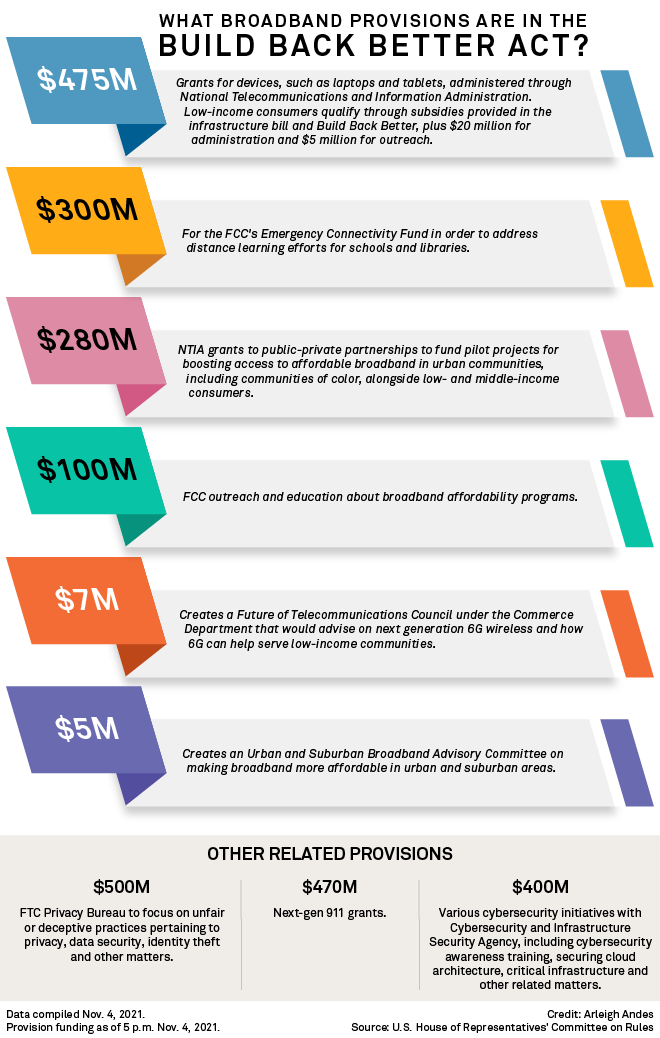S&P Global Offerings
Featured Topics
Featured Products
Events
S&P Global Offerings
Featured Topics
Featured Products
Events
S&P Global Offerings
Featured Topics
Featured Products
Events
Banking & Capital Markets
Economy & Finance
Energy Transition & Sustainability
Technology & Innovation
Podcasts & Newsletters
Banking & Capital Markets
Economy & Finance
Energy Transition & Sustainability
Technology & Innovation
Podcasts & Newsletters
S&P Global Offerings
Featured Topics
Featured Products
Events
8 Nov, 2021
With the U.S. House of Representatives passing a sweeping infrastructure package, major players in the broadband and telecom space are now eyeing the broadband provisions in another piece of legislation.
The $1.75 trillion Build Back Better Act devotes about $1 billion to broadband affordability and accessibility, alongside funding for committees and awareness efforts.
Included in the legislation is $475 million in grant money for devices such as laptops and tablets as part of the Connected Device Grant Program. Under the program, the National Telecommunications and Information Administration would administer funding to community groups that would distribute devices to qualifying Americans. Another provision allocates $100 million to outreach efforts about various broadband affordability programs through the Federal Communications Commission.
These are two of the most important broadband components of President Joe Biden's Build Back Better plan, according to former Rep. Rick Boucher, D-Va., now honorary chairman of the Internet Innovation Alliance.
"Other components we saw in the infrastructure bill would help low-income Americans afford a connection, but the [Connected Device Grant] Program would make sure that they have a device they can use for that connection," Boucher said in an interview with S&P Global Market Intelligence. In terms of outreach, he noted that a lack of knowledge about available programs can significantly hamper enrollment numbers.
The Federal Communications Commission's Emergency Broadband Benefit Program, a pandemic-era subsidy program to help low-income Americans stay connected to the internet, was deployed in May. While the program was funded, outreach efforts were not paid for under the law. The program had a strong start to enrollment, but experts said additional advertising and outreach efforts were needed to better capture more qualifying households.
Other provisions in the Build Back Better plan include funding to create committees that would advise on 6G wireless, as well as help bolster affordable connectivity in urban and suburban areas.

While the Build Back Better package includes several components to further enable broadband access, the $1.2 trillion infrastructure bill passed by the House on Nov. 5 carries more weight for the telecom space, said Matt Wood, vice president of policy and general counsel at media freedom group Free Press.
"The [infrastructure] bill has bigger spends on broadband deployment, digital equity and affordability," Wood said, adding that he would like to see both packages passed into law.
The infrastructure bill allocates $65 for broadband projects, versus just $1 billion in the Build Back Better legislation. Within the $65 billion allotted, $14.20 billion, or nearly 22%, is set aside for the establishment of the Affordable Connectivity Fund. The fund is an extension and reworking of the existing Emergency Broadband Benefit program and has been viewed by experts as a longer-term connectivity subsidy.
Other related provisions in the Build Back Better plan include robust investments in cybersecurity through the Cybersecurity and Infrastructure Security Agency, as well as the creation of a privacy bureau in the Federal Trade Commission.
All told, Build Back Better's likelihood of passage is still up in the air. The House is waiting on an economic analysis from the Congressional Budget Office of the bill's long-term impacts on the budget deficit, known as a CBO score. If the House ultimately passes the bill, it will head to the Senate, where the legislation could undergo further changes.
The president in a Nov. 5 tweet said he was confident the act will pass in the House during the week of Nov. 15.
"It's anybody's guess as to what's going to happen at this point," said IIA's Boucher. "We're not just watching this day-by-day, but hour-by-hour."

